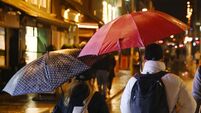Company knew brakes were faulty, bus-crash jury told
The jury in a trial arising from an investigation into a school bus crash in which five schoolgirls were killed has been told that a company knew the vehicle's ABS system was defective but failed to repair it.
Mr Brendan Grehan SC, prosecuting, told the jury in his opening address that gardaí and the Health and Safety Authority carried out an investigation into the crash outside Navan in which Lisa Callan, Claire McCluskey, Amy McCabe, Deirdre Scanlon and Sinead Ledwidge were killed on May 23, 2005.













